Cheltenham Art
Andy Lloyd's Old Masters
Recreating 'Girl with the Pearl Earring' by Vermeer
The work of the 17th Century Dutch artist Johannes Vermeer has always amazed me. His work is inspiring because he managed to capture light so wonderfully well. His portraits are empathic, if a little low-key, which I find endearing. I decided to have a bash at recreating a couple of them this year, both as an exercise in artistic development, and as a tribute to a great artist.

The first painting is of the famous "Girl with the Pearl Earring", an original portrait of almost photographic quality. These images show how my own version of the painting developed:

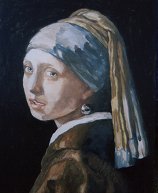
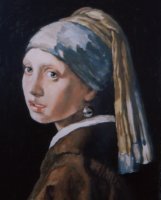
I work in acrylic, unlike the oils used traditionally. Acrylics are very versatile and can be used like oils or like watercolours/gouache. They can be difficult to use, in that the medium dries very quickly. However, that suits me because I break all conventions by painting flat on the table. The paint dries so quickly that I don't find myself dragging colour all over the place accidentally with my hand!

Anyhow, as you can see above my initial sketch didn't quite capture the likeness of the girl with the pearl earring. I had to work on that as the picture built up. In the end I was extremely pleased with the outcome, which has maintained the photograph-like clarity of the original, as well as that amazing expression. The painting is now in a private collection in Israel.
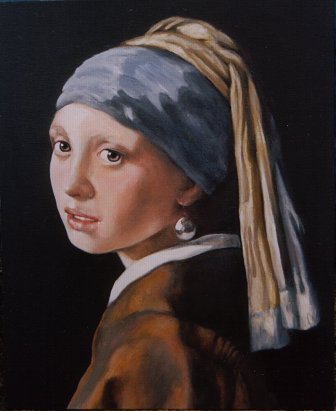
Recreating 'The Milkmaid' by Vermeer
The next exercise I undertook was a more difficult challenge; "The Milkmaid". The feeling of light in this painting is absolutely amazing; not easy to capture at all. Not only that, but there is an incredible level of detail to reproduce, all of which has to melt into the atmosphere of light required. Here's how the painting developed:
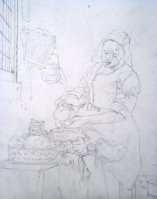
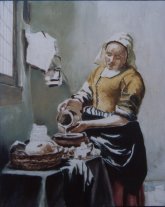
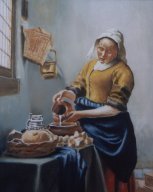
I'm sure my technique is not at all that recommended by professional artists. For starters I work up from very detailed pencil sketches drawn onto the canvas board; a big 'no-no' probably. Then I develop a strong contrast in the picture; using heavy tones for dark areas before lightening them with glazes. Unconventional? Who knows. Either way, here's the (almost) finished product. I did another hour or so after this to provide further detail and clarity; I'll post the final picture when my next film is developed:

Both of these paintings took about 15 hours of intense work to create. You might ask: What's the point? Why not just try and create a piece of art that is entirely original, rather than copying an Old Master? This seems to be a strong argument in art these days, that art is only art when it is taking everyone off in a new direction. I'm not sure that art can be pigeon-holed quite as easily as this. To my mind there is virtue in discovering how previous artists used to work, and employing their techniques to good effect. This means gaining proficient technical skill with paint and brush, which takes literally years of hard work.
I was listening to a French concert pianist talking about Debussy's 'Clair de Lune' the other day. He remarked that a musical student might miss the subtlety that the composer was attempting to convey in his written music. That an shifting atmosphere was being delicately built up which was difficult to hear, let alone play. This remark made me compare painting with playing music. Classical musicians not only have to develop the technical skills, but they must also attempt to understand the creative ideas which underlie a piece of music, and re-create the appropriate feelings intended by the composer. There may be a parallel here with fine art. We can learn technique and feeling from the great artists. There is value in reproducing their work before attempting to create our own compositions.
I was recently asked to create a second reproduction of Vermeer's 'The Milkmaid', this time on a smaller scale. Despite being a smaller picture is took as long to complete, an indication of the level of detail of the Old Master itself. Here's the completed painting, which was taken in full sunlight, so appears a little bit on the bright side:

Recreating 'Boreas' by John William Waterhouse
In summer 2011, I was commissioned to recreate this pre-Raphaelite painting by John William Waterhouse (1903).
The reproduction was slightly larger than the original at 24" x 30". I had to add some extra details along the sides of the painting to compensate, as well as wrapping the painting around the sides of the deep block canvas. Here's how the painting developed:
It's very difficult painting in another artist's style, but also instructive. Waterhouse's style of portraiture is similar to mine in that he likes to create a smooth skin with light tones, but the background was a real challenge. The client also wanted a gothic feel to the reproduction, requiring some very dark tones to be employed in the trees.
At the point of reaching the third stage above, I was fairly convinced I had achieved a reasonably faithful reproduction. This was not as easy to conclude as one might think. It doesn't help that there is such variability on the Internet about how the original painting actually looks. Some of the prints have clearly been doctored, so that creates some confusion. Contrasts and colouring vary, sometimes quite significantly. So which is correct? One could only really tell by standing in front of the original - an option not available to me. My client felt that the dark tones could go deeper, especially in the foliage of the trees, and I plunged further in to the work:
The resulting work has more contrast, and became a more visually striking piece of work. Overall, the painting took about 24 hours to complete, with the initial drawing taking up about 4 hours of that time. The painting is now in a private collection in California.
Contact Details
Originals paintings are available from me directly.
Prints and a range of art-themed paraphernalia can be obtained from Fine Art America.
e-mail: andy-lloyd@hotmail.com
